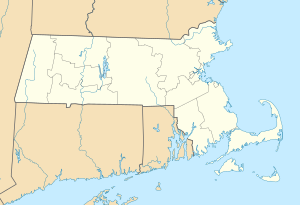Bardwell's Ferry Bridge
Coordinates: 42 ° 33 ′ 20 " N , 72 ° 40 ′ 41" W.
| Bardwell's Ferry Bridge | ||
|---|---|---|
| The bridge in 2005 | ||
| Convicted | Bardwell's Ferry Road | |
| Subjugated | Deerfield River | |
| place | Conway and Shelburne , Massachusetts , United States | |
| construction | Truss bridge ( fish belly girder ) | |
| overall length | 198 ft (60.4 m ) | |
| width | 14 ft (4.3 m ) | |
| height | 40 ft (12.2 m ) | |
| completion | 1882 | |
| planner | William O. Douglas | |
| location | ||
|
|
||
The Bardwell's Ferry Bridge is a fish-bellied girder - truss bridge in the state of Massachusetts of the United States , the Conway with Shelburne over the Deerfield River connects away. It was built in 1882 and entered on the National Register of Historic Places in 2000 .
description
The bridge, located in the foothills of the Green Mountains , replaced a wooden bridge severely damaged in a storm in the late 19th century, which in turn replaced a ferry service that had been operated at the same location by the Bardwell family since the 18th century . The bridge, the street section and a small cluster of residential buildings in the vicinity are named after the family.
The cast or wrought iron framework of the bridge , which is a little more than 60 m long, is lens-shaped , which is why it is also referred to as lens framework, parabolic framework or elliptical framework. The entire framework is anchored to portals on both sides of the bridge. The bridge is still largely in its original condition today.
Historical meaning
The bridge is one of the ten surviving bridges of this type in Massachusetts; there were fewer than 50 of them in the United States by 2000. The lenticular framework had been widespread in Europe for a good ten years before the first American patent for this type of construction was applied for in the 1850s. Bardwell's Ferry Bridge was built on principles that William O. Douglas had applied for a patent in 1878.
The fish-belly girder truss combined the mechanical and physical advantages of arch, suspension and truss bridges in a single structural system. The developers advertised the design as "safety through redundancy", although the three combined construction methods together actually did not show any improvement in stability compared to other construction forms. The complex optics and construction gave the appearance of a very safe bridge and made the lens design very popular.
The elliptical design of the Bardwell's Ferry Bridge is based on a patent from Binghamton, New York born William O. Douglas, which he had registered in 1878. His patent, however, was only a variant of the well-known fish belly carrier, which went back to the German Georg Ludwig Friedrich Laves and was used for the first time in 1839. The British engineer Isambard Kingdom Brunel also used the design on the Royal Albert Bridge, built in 1859 . The first patents for this existed in the USA as early as 1851, but the patent from Douglas made his employer Berlin Iron Bridge Company from Berlin, Connecticut, the only nationwide manufacturer of this bridge shape. With the exception of the Smithfield Street Bridge in Pittsburgh designed by Gustav Lindenthal , all fish-belly girder bridges that still exist today were manufactured by this company.
On February 10, 2000, the bridge was entered on the National Register of Historic Places under number 00000076 .
See also
literature
- Frederick Kreitner, Neil Larson, Betsy Friedberg: National Register of Historic Places Registration Form. (PDF) United States Department of the Interior , National Park Service , January 2000, accessed on August 18, 2017 (English, accessible via the "NR" button).

